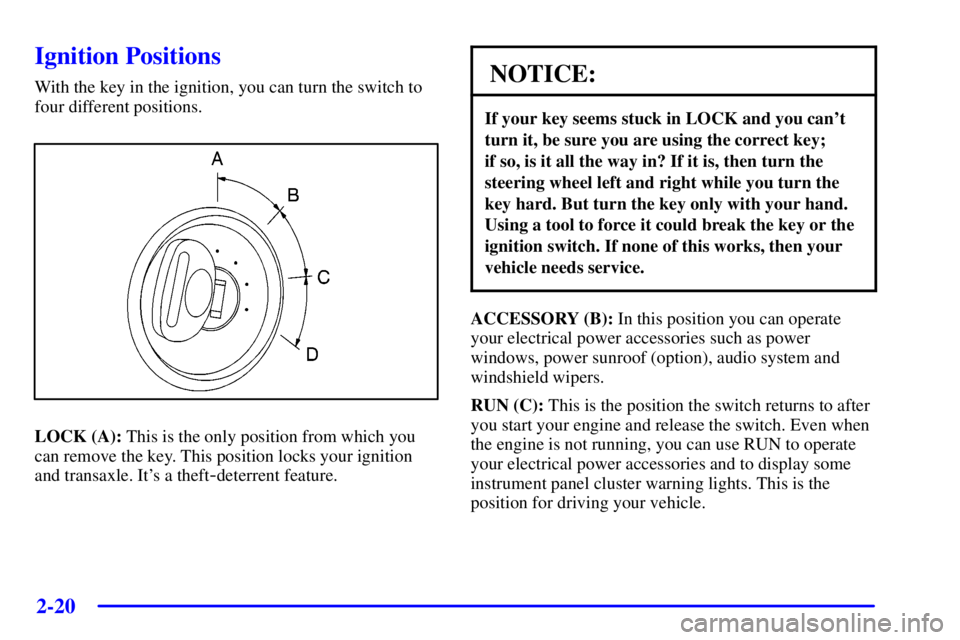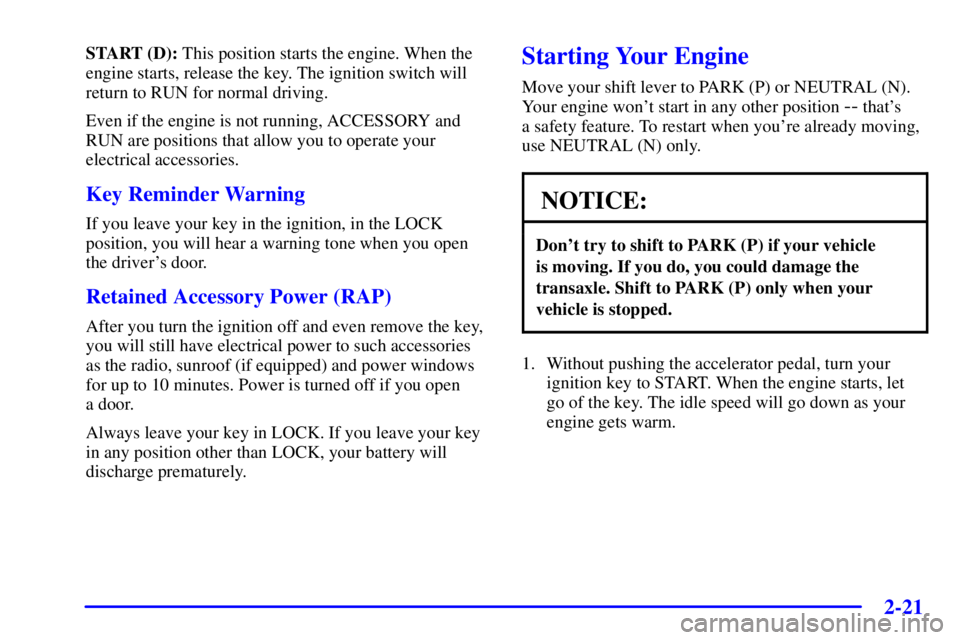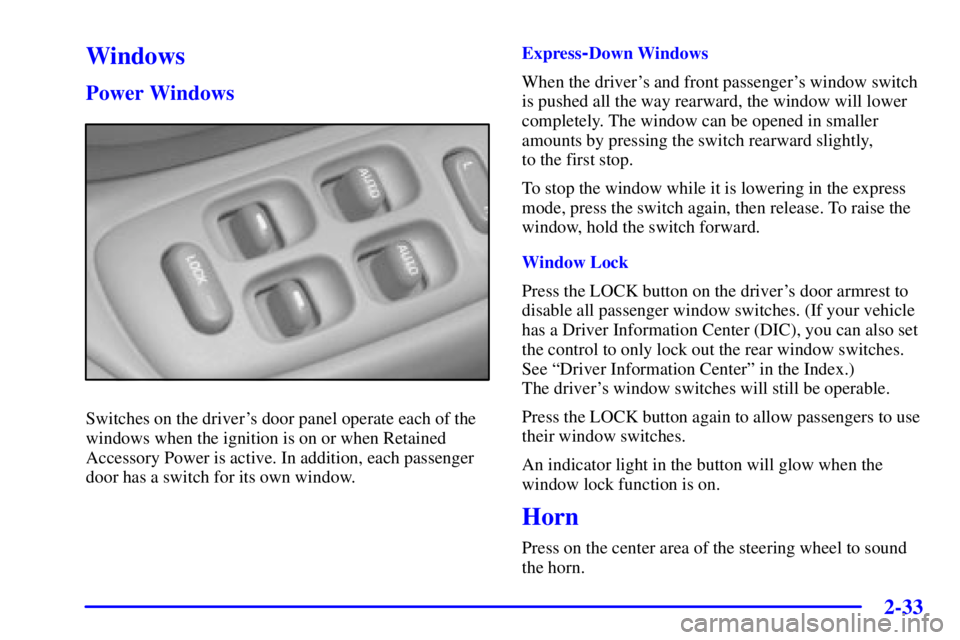Page 78 of 402

2-14
Trunk
CAUTION:
It can be dangerous to drive with the trunk lid
open because carbon monoxide (CO) gas can
come into your vehicle. You can't see or smell
CO. It can cause unconsciousness and even death.
If you must drive with the trunk lid open or if
electrical wiring or other cable connections must
pass through the seal between the body and the
trunk lid:
�Make sure all other windows are shut.
�Turn the fan on your heating or cooling
system to its highest speed with the setting
on OUTSIDE AIR or with RECIRC turned
off. That will force outside air into your
vehicle. See ªComfort Controlsº in
the Index.
�If you have air outlets on or under the
instrument panel, open them all the way.
See ªEngine Exhaustº in the Index.
Trunk Lock Release
To unlock the trunk from the outside, insert the master
key and turn it.
Remote Trunk Release (Option)
If you have this option,
press the trunk release
button located in the glove
box to open the trunk lid.
The key does not have to be in the ignition for the
remote trunk button to work. The transaxle must be in
PARK (P) or NEUTRAL (N). The system also works
with the remote keyless entry system, if your vehicle has
this feature.
Page 79 of 402

2-15 Remote Trunk Release Lockout (Option)
To secure items in the trunk, lock the glove box with the
master key and take your key and remote keyless entry
transmitter with you. The gray valet key cannot open the
trunk or the glovebox.
Trunk Security Override (Option)
Pressing the trunk symbol on the remote keyless entry
transmitter opens the trunk even if the glove box is locked.
Theft
Vehicle theft is big business, especially in some cities.
Although your vehicle has a number of theft
-deterrent
features, we know that nothing we put on it can make it
impossible to steal. However, there are ways you can help.
Key in the Ignition
If you leave your vehicle with the keys inside, it's an
easy target for joy riders or professional thieves
-- so
don't do it.
With the ignition off and the driver's door open, you'll
hear a tone reminding you to remove your key from the
ignition and take it with you. Always do this. Your
ignition and transaxle will be locked. And remember to
lock the doors.
Parking at Night
Park in a lighted spot, close all windows and lock your
vehicle. Remember to keep your valuables out of sight.
Put them in a storage area, or take them with you.
Parking Lots
If you park in a lot where someone will be watching
your vehicle, it's best to lock it up and take your keys.
But what if you have to leave your ignition key?
�If possible, park in a busy, well lit area.
�Put your valuables in a storage area, like your trunk
or glove box. Be sure to close and lock the
storage area.
�Close all windows.
�Lock the glove box.
�Lock all doors except the driver's.
�Give the valet key to the valet. Then take the master
key with you.
Page 81 of 402

2-17 Testing the Alarm
1. From inside the vehicle, roll down the window.
2. Activate the system by locking the doors with the
power door lock switch while the door is open, or
with the remote keyless entry transmitter.
3. Get out of the vehicle, close the door and wait for the
SECURITY light to go out.
4. Then, reach in through the window, unlock the door
with the manual door lock and open the door.
This should set off the alarm.
If the alarm does not sound when it should, check to
see if the horn works. The horn fuse may be blown.
To replace the fuse, see ªFuses and Circuit Breakersº
in the Index.
If the alarm does not sound, or the exterior lamps do not
flash, see your dealer.
PASS-Key� III
Your vehicle is equipped
with the PASS
-Key III
(Personalized Automotive
Security System)
theft
-deterrent system.
PASS
-Key III is a passive
theft
-deterrent system.
This means you don't have to do anything different to
arm or disarm the system. It works when you insert or
remove the key from the ignition.
Your PASS
-Key III system operates on a radio
frequency subject to Federal Communications
Commission (FCC) Rules and with Industry Canada.
Page 84 of 402

2-20
Ignition Positions
With the key in the ignition, you can turn the switch to
four different positions.
LOCK (A): This is the only position from which you
can remove the key. This position locks your ignition
and transaxle. It's a theft
-deterrent feature.
NOTICE:
If your key seems stuck in LOCK and you can't
turn it, be sure you are using the correct key;
if so, is it all the way in? If it is, then turn the
steering wheel left and right while you turn the
key hard. But turn the key only with your hand.
Using a tool to force it could break the key or the
ignition switch. If none of this works, then your
vehicle needs service.
ACCESSORY (B): In this position you can operate
your electrical power accessories such as power
windows, power sunroof (option), audio system and
windshield wipers.
RUN (C): This is the position the switch returns to after
you start your engine and release the switch. Even when
the engine is not running, you can use RUN to operate
your electrical power accessories and to display some
instrument panel cluster warning lights. This is the
position for driving your vehicle.
Page 85 of 402

2-21
START (D): This position starts the engine. When the
engine starts, release the key. The ignition switch will
return to RUN for normal driving.
Even if the engine is not running, ACCESSORY and
RUN are positions that allow you to operate your
electrical accessories.
Key Reminder Warning
If you leave your key in the ignition, in the LOCK
position, you will hear a warning tone when you open
the driver's door.
Retained Accessory Power (RAP)
After you turn the ignition off and even remove the key,
you will still have electrical power to such accessories
as the radio, sunroof (if equipped) and power windows
for up to 10 minutes. Power is turned off if you open
a door.
Always leave your key in LOCK. If you leave your key
in any position other than LOCK, your battery will
discharge prematurely.
Starting Your Engine
Move your shift lever to PARK (P) or NEUTRAL (N).
Your engine won't start in any other position
-- that's
a safety feature. To restart when you're already moving,
use NEUTRAL (N) only.
NOTICE:
Don't try to shift to PARK (P) if your vehicle
is moving. If you do, you could damage the
transaxle. Shift to PARK (P) only when your
vehicle is stopped.
1. Without pushing the accelerator pedal, turn your
ignition key to START. When the engine starts, let
go of the key. The idle speed will go down as your
engine gets warm.
Page 95 of 402
2-31
Parking Over Things That Burn
CAUTION:
Things that can burn could touch hot exhaust
parts under your vehicle and ignite. Don't park
over papers, leaves, dry grass or other things that
can burn.
Engine Exhaust
CAUTION:
Engine exhaust can kill. It contains the gas
carbon monoxide (CO), which you can't see or
smell. It can cause unconsciousness and death.
You might have exhaust coming in if:
�Your exhaust system sounds strange
or different.
�Your vehicle gets rusty underneath.
�Your vehicle was damaged in a collision.
�Your vehicle was damaged when driving over
high points on the road or over road debris.
�Repairs weren't done correctly.
�Your vehicle or exhaust system had been
modified improperly.
If you ever suspect exhaust is coming into
your vehicle:
�Drive it only with all the windows down to
blow out any CO; and
�Have your vehicle fixed immediately.
Page 97 of 402

2-33
Windows
Power Windows
Switches on the driver's door panel operate each of the
windows when the ignition is on or when Retained
Accessory Power is active. In addition, each passenger
door has a switch for its own window.Express
-Down Windows
When the driver's and front passenger's window switch
is pushed all the way rearward, the window will lower
completely. The window can be opened in smaller
amounts by pressing the switch rearward slightly,
to the first stop.
To stop the window while it is lowering in the express
mode, press the switch again, then release. To raise the
window, hold the switch forward.
Window Lock
Press the LOCK button on the driver's door armrest to
disable all passenger window switches. (If your vehicle
has a Driver Information Center (DIC), you can also set
the control to only lock out the rear window switches.
See ªDriver Information Centerº in the Index.)
The driver's window switches will still be operable.
Press the LOCK button again to allow passengers to use
their window switches.
An indicator light in the button will glow when the
window lock function is on.
Horn
Press on the center area of the steering wheel to sound
the horn.
Page 102 of 402
2-38
Windshield Washer
At the end of the wiper lever, there's a button. To spray
washer fluid on the windshield, push the button until
you have enough fluid to clean the windshield. The
wipers will clear the window and either stop or return to
your preset speed.
CAUTION:
In freezing weather, don't use your washer until
the windshield is warmed. Otherwise the washer
fluid can form ice on the windshield, blocking
your vision.
A WASHER FLUID warning light will indicate if the
fluid level in the windshield washer reservoir is low. See
ªLow Washer Fluid Warning Lightº in the Index.
Cruise Control
With cruise control, you can
maintain a speed of about
25 mph (40 km/h) or more
without keeping your foot
on the accelerator. This can
really help on long trips.
Cruise control does not work at speeds below about
25 mph (40 km/h).
When you apply your brakes, the cruise control
shuts off.